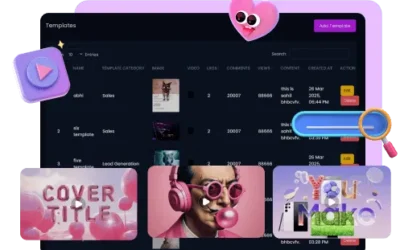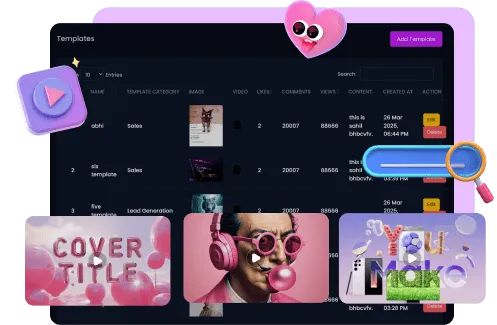In the age of visual overload, the ads that captivate us don’t just sell—they tell stories, evoke emotion, and leave lasting impressions. The secret? Cinematic techniques. When combined with the power of 3D design, these filmmaking principles create video ads that feel more like short films than sales pitches.
For platforms like Regards, where scroll-stopping creative is essential, cinematic 3D ads can dramatically improve engagement and retention. But what exactly makes a 3D ad feel “cinematic”? Let’s explore the techniques that bring visual magic to life.
🎥 1. Dynamic Camera Work
Like in film, the camera is the audience’s eye. Strategic movement can transform a basic render into a high-impact visual journey.
Common cinematic camera techniques in 3D ads:
- Dolly zooms to create dramatic tension or focus
- Crane or orbital shots to introduce products in a heroic light
- Handheld-style movement for intimacy and realism
- Tracking shots that follow an object through a 3D space
Smooth, purposeful camera motion enhances narrative flow and keeps the viewer engaged throughout the ad—especially important in short-form formats like those on Regards.
💡 2. Lighting for Mood and Emotion
Lighting isn’t just a technical requirement—it’s a storytelling tool. The way a product or environment is lit can dramatically influence how it’s perceived.
Cinematic lighting techniques include:
- Chiaroscuro: High-contrast lighting to create depth and drama
- Soft key lighting: For warmth, elegance, or luxury
- Rim lighting: To define product outlines and add separation from the background
- Color grading: To stylize scenes and evoke specific moods (cool blues for tech, warm ambers for lifestyle)
When used intentionally, lighting doesn’t just highlight features—it adds emotional weight.
🧩 3. Composition and Framing
In cinema, every frame is a painting. In 3D ad design, framing tells the viewer what matters without using a single word.
Techniques to consider:
- Rule of thirds: Placing key objects off-center to create tension or balance
- Leading lines: Using environmental elements to guide the viewer’s gaze
- Negative space: Drawing attention to the product by using emptiness effectively
- Symmetry and depth: To create an elevated, premium aesthetic
For short attention spans on platforms like Regards, strong composition ensures the message lands at a glance.
⏱️ 4. Timing, Pacing, and Rhythm
Just like in film editing, the pacing of cuts, transitions, and motion in a 3D ad can define its impact. A slow zoom-in can build tension. A fast cut with upbeat music can energize the audience.
Elements to fine-tune:
- Transition timing: Keep cuts tight, usually every 1–3 seconds
- Motion sync with sound: Align movements with beats or effects for satisfaction
- Build-up and payoff: Begin with intrigue, end with a strong call to action (CTA)
Ads on Regards may only last 10–30 seconds—but within that window, rhythm and timing can make or break engagement.
🌀 5. Depth of Field and Focus Pulls
Shallow depth of field, blur, and rack focus are cinematic staples—and they translate beautifully into 3D.
Uses in 3D ads:
- Focus pulls between product features (foreground to background)
- Blurred backgrounds to isolate the subject
- Tilt-shift effects to simulate macro photography for detail shots
These techniques lend a “real camera” feel to the animation and reinforce product hierarchy in visual storytelling.
🪄 6. Visual Effects (VFX) for Storytelling
While restraint is important, well-placed visual effects can enhance the cinematic flair of a 3D ad.
Examples include:
- Particle effects for energy, motion, or transformation
- Lens flares, bokeh, and bloom for polish and atmosphere
- Slow-motion sequences to highlight quality or craftsmanship
- Physics simulations (liquids, cloth, smoke) to make scenes feel alive
In cinematic 3D ads, effects aren’t there for show—they amplify the message and elevate the aesthetic.
🔄 7. Sound Design and Score
Although many video ads on platforms like Regards auto-play silently, sound is still an essential part of cinematic storytelling when enabled.
Techniques that contribute to visual magic:
- Cinematic scores that mirror the pacing of the visuals
- Layered sound effects that add realism and weight
- Sound-reactive animation where visual beats sync with audio hits
Even in silence, well-scored visuals can evoke emotion through the suggestion of sound—one reason why many designers animate as if sound is always present.
🌟 Final Touch: Color Grading and Post-Production Polish
No cinematic piece is complete without color grading and post-processing.
In 3D ads, this includes:
- Contrast and tone curve adjustments
- Lens distortion or film grain overlays
- Vignettes to frame the subject subtly
- Color LUTs to match a brand’s aesthetic or desired mood
The goal is to give the final piece a unified, intentional look—what filmmakers call “the final grade.”
💼 Why Cinematic 3D Ads Work for Brands
Cinematic 3D ads are emotionally persuasive, visually stunning, and strategically effective. They:
- Improve viewer retention
- Boost brand perception
- Increase click-through rates
- Create memorable experiences in a short time
On platforms like Regards, where creativity meets conversion, cinematic techniques give brands a powerful edge.
🎬 Wrapping Up
Great 3D ad design doesn’t just showcase—it storyboards, directs, and edits with the same care as a short film. By borrowing from cinema, advertisers create 3D visuals that captivate hearts and convert minds.
The next time you craft a video ad, don’t just ask: “Is it clear?”
Ask: “Is it cinematic?”
Because visual magic isn’t an accident—it’s a technique.







0 Comments